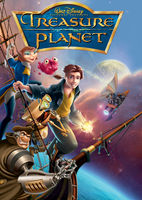
In the animated film Treasure Planet anthropomorphism is used as a narrative tool within a wider concept of Hyperrealism which is ‘Disney Studio’s application of realist conventions of narrative, logical causality and character motivations – breaking with the largely non-realist and anarchic dynamics of the cartoon form.’ Anthropomorphism is used throughout this film as many of the main characters are animals with human attributes, such as Captain Amelia who is a cat but stands upright and speaks like a human. In contrast to this there are two key scenes with a creature called Morph; the first scene is where Morph emulates Captain Amelia by morphing into a miniature version of her and parroting the phrase ‘spaceport floozies’ while the second key scene is when John Silver gives Morph to Jim. These scenes are key because of their relation to the concept of hyperrealism; Morph is a creature who is treated like a pet and he cannot speak of his own volition unless he is imitating one of the other more human animals. Morph is a character who simultaneously reinforces and questions the hyperreal world through the scenes where he copies Amelia and later when he is given away, as he provides a point of contrast to the more intelligent, humanlike animals. Morph is presented like a pet because he lacks the language skills of characters like Amelia yet he reinforces the hyperreal because he can imitate them; therefore this mixture of human and animal characteristics reinforces notions of realism while simultaneously reminding the audience that the narrative takes place in a non-realist animated universe. Morph serves as a further reminder of the non-realist cartoon form in the scene where Silver gives him away because he turns into a hat, which is an inanimate object and therefore pushes the boundaries of realism in Treasure Planet even further.